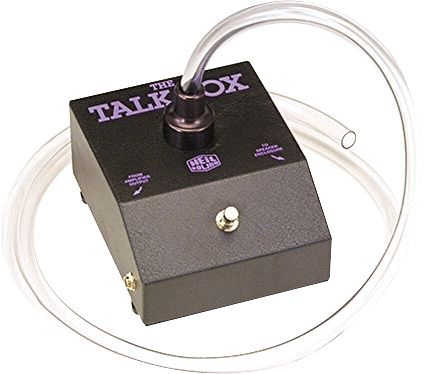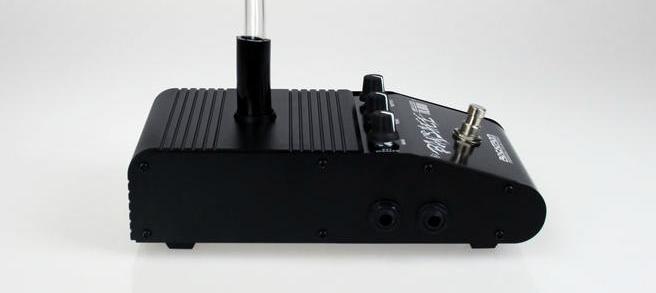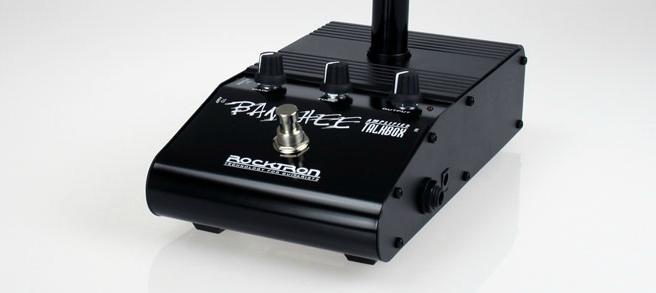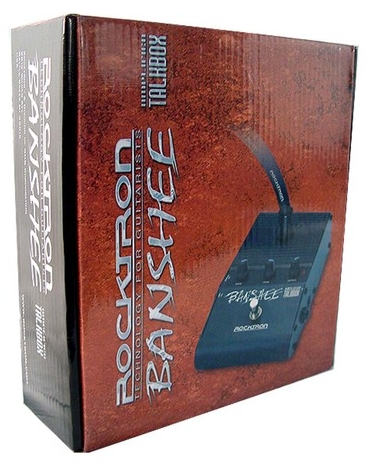Rocktron Banshee Talk Box
TO BEGIN WITH...
Every guitar player needs a few frivolous gadgets. Every one. We are talking about those “I’ve always been fascinated with this,” kinds of things. Uh-huh. Here’s one of mine: The “talk box” for electric guitar. I got it as a gift after having repeatedly put it on my Christmas list for years. I'm not sure I would have ever sprung for it myself, despite the fact that I was playing a standing gig where I opened with a song that absolutely begged for it. What's a talk box? I'm glad you asked! Let’s get this started off right, with the song that put this effect on the map, and the song that begged for it. It's Joe Walsh's and Barnstorm's "Rocky Moutain Way." You’ll hear the effect starting with the solo at 3:10. Joe Walsh created quite a stir with this song in 1973 when it climbed to #23 on the pop charts. The voice box really brought the song some attention in an era when audiences were hungry for new sounds. I was fascinated by the effect back then and read up on it in every article I could find in the guitar magazines, especially in interviews with Joe. As it turns out, Joe wasn't the first to use it and there’s a lot of history behind this ground-breaking moment in music history. Would you believe that the effect was first heard in 1939? That year, pedal steel guitar player Alvino Rey converted a microphone into a driver that his wife held against her throat like a prosthetic voice box to create a voice-modulated steel guitar. Then in 1940, Kay Kyser debuted a device on film called the Sonovox that involved two speaker drivers placed against the throat. The film was clearly based around a pre-recorded sound track because the acoustic instruments that are driving the Sonovox and the Sonovox itself are being seen together, both off-mic. But the film demonstrated the technique and the soundtrack demonstrated the results.
THE MODERN ERA
In the mid-1960s, engineer Bill West (first husband of Country singer Dottie West) created the first of the current configuration talk of boxes for pedal steel player Pete Drake. This was a low-wattage unit with a paper cone, using a funnel to feed the sound into a tube which went in the player’s mouth. Joe Walsh had become a friend of Dottie West and would visit her when his band, the James Gang, was in Nashville. One day around 1970 Bill brought the talk box unit out of his garage and gave it to Joe, saying, “Here try this out. You’ll figure it out.” Being a ham radio operator with electronics and mechanical skills who worked on his own amps and gear, Joe fiddle with it and built his own version. After he practiced on it for a while he used it on “Rocky Mountain Way.” His was also a low-wattage version suitable only for use with small amps in the studio. When the song became a hit and he needed to play it on the road, Joe took the unit to audio engineer Bob Heil for help. On a Sunday afternoon they put together an industrial-grade version to handle the output of the high wattage amps Joe was using onstage. Bob then built and commercially released that design. There were other low-power designs during the period, including "The Bag" from Kustom, the guts of which hung over the player's shoulder in a bag.
Then in 1974, Peter Frampton’s girlfriend asked Bob Heil for an idea for a Christmas gift for Peter. Bob packaged up one of his talk boxes for her. Peter worked with it for two weeks and came up with another couple of mileposts of the talkbox, "Do You Feel Like We Do" and "Show Me the Way."
Read More: Top 10 Talk Box Songs | https://ultimateclassicrock.com/talk-box-songs/?utm_source=tsmclip&utm_medium=referral
From there, use of the box spread to other rock guitar players such as David Gilmour of Pink Floyd, Jeff beck, Joe Perry of Aerosmith, Brian May of Queen, Dan McCafferty of Nazareth, and Richy Sambora of Bon Jovi.

THE ORIGINAL HIGH-WATTAGE DESIGN
The heart of the Heil unit was an unpowered 250 watt compression driver. A speaker cable from the guitar amp’s speaker output fed a bypass switch that selected between either feeding the signal back to your speakers via another speaker cable (and thus bypassing the effect) or feeding it to the compression driver for the effect. The driver’s acoustic output was fed into a tube that was inserted into the mouth. Sounds (pitches) created by the guitar were modulated or articulated by the mouth of the player. For stage use, the mouth sounds were picked up by a microphone because the unit is too quiet to stand on its own. This became known as the "Heil Talk Box." In 1988, Dunlop manufacturing bought the rights to manufacture the unit but kept the name. It is still available for about the same cost as the Banshee.

THE ROCKTRON BANSHEE
The Rocktron division of GHS Corporation took a look at the talk box concept and decided that they could create one that required less muss and fuss. They designed a unit containing a preamp with controls, a five-watt amp, a compression driver feeding the tube, and a guitar-level true-bypass circuit to your amp, all nicely packaged so that the unit can be included in your pedal board. The beauty of this design is that lives entirely in the input chain of your guitar rig, eliminates the multiple speaker lines running to and from the amp and potential damage to the amp, and removes the need for the high-wattage handling capacity. The Banshee consists of a sheet-steel pedal package with controls and connectors, a nine-volt wall wart, and a tube to conduct the sound of the unit to your mouth. Though the unit is fairly large, it will still fit on a pedal board.


The Banshee is terribly straightforward. Just like an amplifier, you can play it clean or driven by tweaking the settings of the gain and volume controls. Like the amp-fed units, the gained-up sound is excellent with plenty of crunch and compression as you add gain. This was kind of a deal-maker-or-breaker to me – if the sound wasn’t like the amp-driven ones it would have been useless to me. You can easily run this at the front of your signal chain and play nothing but guitar into it. From what I can tell, most guitar players have opted for this sound. As we've come to find out, a five watt amp is plenty for moderate playing situtions. Knowing that the sound will be picked up by a mic as all talk boxes are, the Banshee's five-watt amp provides plenty of power to the tube for this application. In fact, when wound out, the five little watts can rattle your teeth around pretty darned well. I can't imagine the power of the original units banging around on my molars. The rest of the effect is in your hands… and your mouth.
APPLICATION NOTES
You soon realize that whatever sparkle you bring to this effect is only limited by how well and how creatively you are able to move your lips and tongue to modulate the sounds and how well you are able to integrate that modulation with your guitar playing. Like the eBow, there's some technique to be developed. You also come to realize that it is going to take a bit of fiddling to come up with a mic stand placement that allows you to occasionally look down at your guitar as needed to make a complicated location change on the neck. Joe Walsh has always used a Les Paul with a distorted sound on his voice box. It appears that the strength of that combination makes single-note leads work well and prevents feedback. Try not to back off too far on the Banshee's tone control – the effect seems to want some overtones in order to be properly articulated by the mouth. Swallow your spit so it doesn’t wander down the tube. And yes, you will look funny playing the darned thing. Walsh has decided to surf the strangeness and makes funny faces and rolls his eyes while he plays his. I like that.
A USAGE CAUTION
While this effect turns heads and makes people say, “Hey, what the heck was that?” it is truly a novelty, an aural confection. Probably the best rule to govern its use is, “Leave them wanting more.” Joe Walsh definitely lives by this rule - he often doesn’t do more than a few bars with his talkbox in an entire evening. I’ve never seen an artist use one of these any more than once or twice in a concert because I get the feeling it can get old quickly. Even Peter Frampton’s use in an extended solo can seem a little drawn out to me. Use with caution.

WHAT’S IN THE BOX:
Footswitch/driver unit, power supply wall-wart, hygienically sealed voice tube, velcro mic stand tube anchor, manual, extra feet for the unit.
INS AND OUTS
(All side-mounted) One guitar input, one guitar level true-bypass output, one 5 watt, 8 ohm speaker out that automatically bypasses the internal driver and allows use of the amp as a practice amp, standard barrel style nine-volt AC power jack, (top mounted) socket for the voice tube
CONTROLS AND INDICATORS
Gain, Tone, and Volume Pots, Bypass Footswitch, Power LED
SPECIFICATIONS:
Maximum Input: +9.5dbu
Input Impedance: 1m ohms
Current Consumption: 1.03A@ 5 watts
Power Requirements: 9vac
Minimum Load on Output: 8 ohms
Output Power: 5w @ clipping (8 ohms load)
Suggested retail price: $279 Street price: $169.99
PURCHASE CAUTION
Before opening the package, make up your mind – there’s a seal on the box. For hygiene reasons, the unit is non-returnable once you break that seal. And that is why I wrote this review.
AND FINALLY...
There is an upgrade version of the device, the Banshee 2, that adds an effects loop, the ability to run the effect and your amp at the same time, an effect “on” LED, and an average $80 price increase. I, for one, had no need for those features.

(Click to visit)
= =
=






